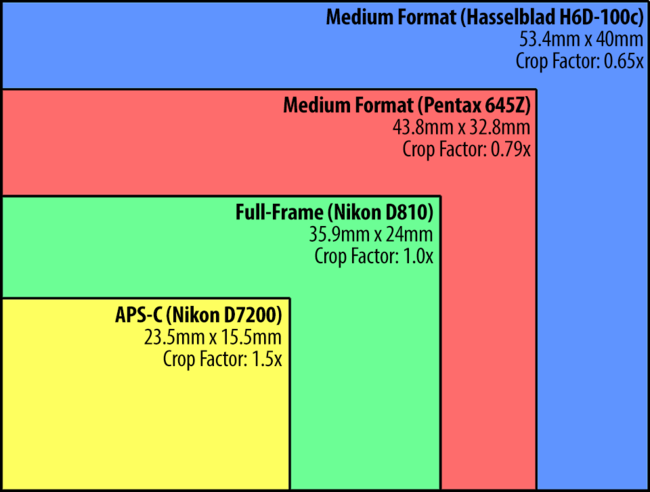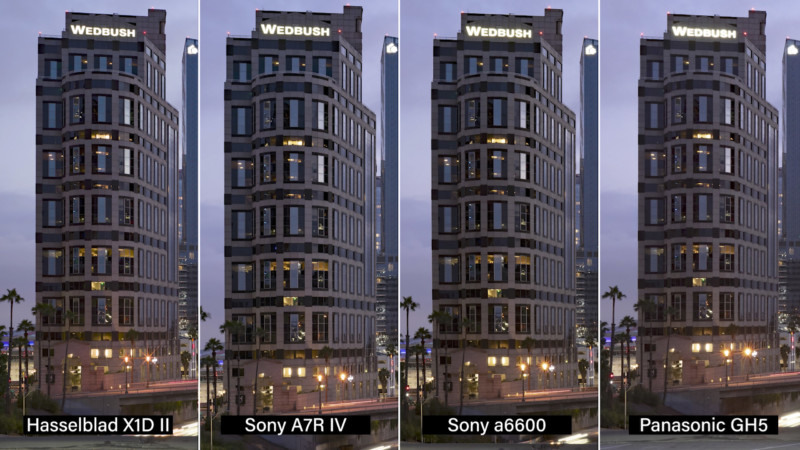


For example, on a Canon 5D Mark IV using a Canon 50mm f/1.4 lens gives the equivalent focal length or field of view as using a 31mm lens on a Canon 7D since it has a 1.6 crop multiplier (31mm x 1.6 = 50mm).

Smooth bokeh in the full-frame camera is because the larger the sensor, the longer the focal length of the lens needs to be to capture the same field of view. When shooting at the same effective focal length, using the same aperture settings, and shooting from the same angle/distance to the subject, the full-frame camera will have a shallower depth of field ( better bokeh) than the crop sensor camera.
#Full frame vs medium format full
Wider field of view on a Full frame camera for the same lensĪ full-frame DSLR will have a shallower depth of field than a crop sensor DSLR, which translates to silkier bokeh. The medium format cameras will thus not be addressed here specifically, but the same principles still apply.Ī comparative image with sensors inside a full frame vs crop sensor camera is shown below: Medium format and larger sensors exist, however, these are far less common and currently prohibitively expensive eg. Many modern cameras boast a sensor larger than 35mm.Ĭamera phones and other smaller compact cameras use sensor sizes in the range of ~1/4″ to 2/3″. The 35mm film format has been the standard in film gauge since 1909 due to its balance in cost and image quality and has stuck ever since. Sensor Size Comparison – Crop Sensor vs Full Frame vs Medium Format Why is the 35mm format considered to be the standard or a “full-frame”? Check the image below for a comparative idea of sensor size in different cameras. In medium format cameras, the size of the sensor is larger than 35mm. A crop sensor camera means that the size of the sensor is smaller than 35mm. The term “full frame” refers to a sensor size that has the same dimensions as the 35mm film format. There is a difference in sensor size inside a Full-frame vs a Crop Sensor Camera. When it comes to sensor sizes, the two terms used to classify them are “full-frame” and “crop sensor”. The size of the camera sensor directly affects the quality of the photographs. These digital sensor acts just like film rolls except for they can be used as long as it’s in working condition. The modern component of a camera which replaced the film rolls is called the camera ‘Sensor’. Modern digital cameras have entirely replaced the physical film rolls. This negative was later developed into a positive which used to be an actual photograph. This film when exposed to light through the lens would create a negative of the image as seen through the lens. In the older days when film cameras were used, there used to be negative film rolls inside the camera. A Camera Sensor in Nikon ( encircled in yellow) Film vs Digital Sensor The size of the sensor inside the camera determines the field of view, image size, depth of field, resolution, low-light performance, a camera’s physical size, and color depth. More information on the sensor translates to better photo quality. This means that a large sensor size will process a greater amount of light while giving more detailed information to the camera. Conclusion – Full Frame vs Crop Sensor CameraĪ camera sensor is a mechanical hardware inside a digital camera that senses the information with the light coming in through the lens.Full Frame or Crop Sensor – Which is Better?.Why is the 35mm format considered to be the standard or a “full-frame”?.


 0 kommentar(er)
0 kommentar(er)
